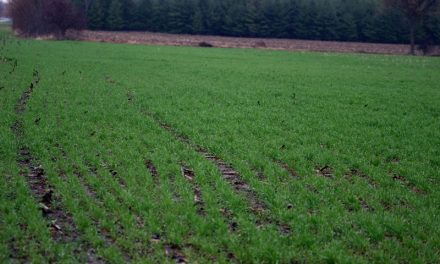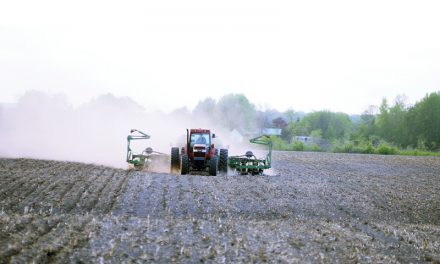Gaëlle Thouny, dairy advisor for UNIAG Cooperative led the presentation about the use of inoculants in silage. She is under the tent surrounded by an interested group of farmers. Morin Photo
ST. ALBERT – The UNIAG Cooperative hosted a field day on July 5 about the importance of using inoculants in silage, especially in corn.
The good weather brought out a good group of interested farmers and farm families.
The presentation was hosted by Gaëlle Thouny, dairy advisor.
Thouny talked about the reason why inoculants would be a wise choice for adding to corn silage.
Kelly Allen a field crop advisor with UNIAG said they hold two similar seminars each year showcasing different topics and products.
“We have a good team and hopefully this event will become routine in the future. We plan to have another one in September,” he said.
Corn silage is used as a high-energy forage for dairy cows. This is important for high-producing herds and on farms experiencing problems with making or buying high quality hay crop forage. Corn silage, with its relatively high-energy content, it is also well adapted for use in low-cost rations for fattening cattle.
Thouny explained why she felt inoculants were a good idea. She said, “Since the harvest of corn silage lasts one day or a couple of days, and we feed it to our high producing cows all year long, it’s important to maximize its quality.
More and more farms use a large amount of this forage in their ration, another reason to put emphasis on the management at harvest.
The use of inoculant is part of a good silage management, including right maturity, right dry matter, proper length of cut, and use of processor. We have enough data now to support the effectiveness of microbial inoculants.”
Inoculants are bacteria that help the forage to ferment well.
The result of their application is to cause a drop in the pH of the silage. The term pH refers to a scale used to specify the acidity or basicity of the moisture level in stored silage.
The drop will create stable and good quality feed without significant nutrient loss.
Different bacteria work at different levels of pH:
- the homolactic inoculant gathers E.Faecium, L.Planturum, L.Lactis, it produces lactic acid and prevent clostridia in the silage that will cause spoilage of nutrients (proteins) and deterioration of the quality.
Moreover, lactic acid is a source of energy for the cow, and researches showed that it also increases Dry Matter Intake.
- the heterolactic inoculant includes L. Buchneri; it will produce acetic acid to stabilize the silage in the presence of oxygen. It is an inhibitor of yeasts and moulds.
“As bacteria are alive, we have to pay attention where to store it before and during the harvest,” said Thouny.
“Researches have shown that half of the bacteria become inefficient above 30 C temperature,” she said.
“Always keep the bottle in a fridge. During the harvest, if the fridge is far away, use a cooler with bottles of ice.”
If you going to be keeping an inoculant container set on the harvester, put some bottles of ice inside the container.
Researchers in the United States have calculated a return on investment of 1/3 for nutrients lost, and 7/1 for gain of production with an increase of Dry Matter Intake, when using inoculants.
In an upright silo of 600 MT, we need 2 per cent of the amount of silage to pay the homolactic product, and most of the studies have shown a loss of 5 per cent of nutrients without using an inoculant.
This is directly linked to the net margin of dairy farms, because quality forages results in more milk.













